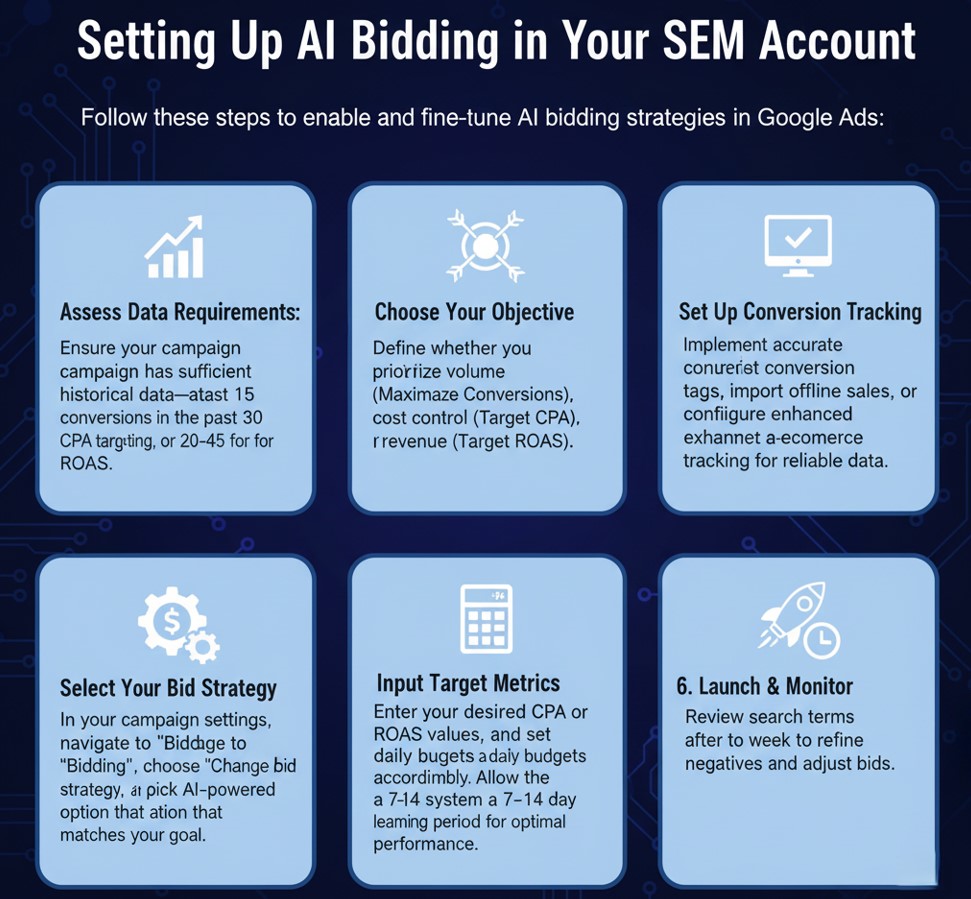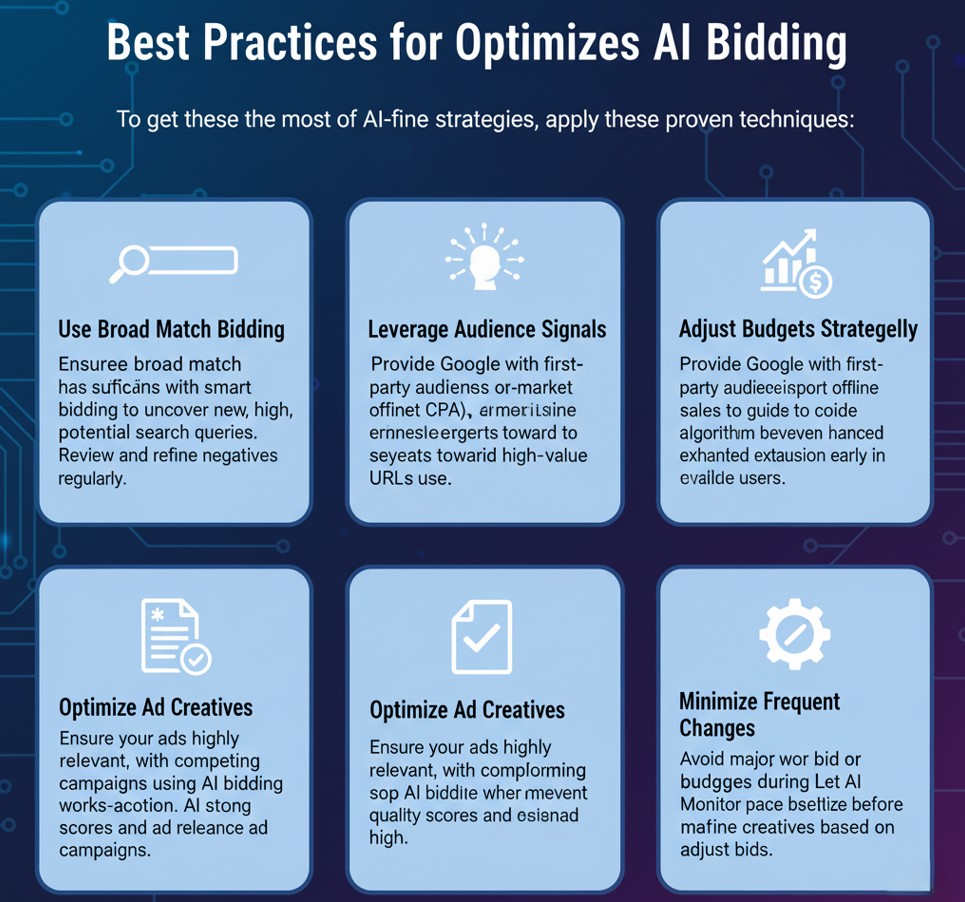
In today’s fast-paced digital advertising landscape, automated and AI-powered bidding has become essential for achieving peak performance in Search Engine Marketing (SEM). Gone are the days when manual bid adjustments and time-consuming spreadsheet analyses delivered optimal results. With AI-powered bidding strategies, marketers can harness machine learning and real-time data signals to optimize bids for each auction, maximize conversions, and boost return on ad spend (ROAS). In this comprehensive guide, we’ll explore how to implement and refine AI-driven bid strategies in your SEM campaigns to supercharge growth.
Why AI-Powered Bidding Matters in SEM
Traditional manual bidding requires constant monitoring, hypothesis testing, and manual tweaks—efforts that often lag behind rapidly shifting consumer behaviors and competitor actions. AI-powered bidding strategies leverage machine learning algorithms to:
- Analyze massive datasets in real time, including device, location, time of day, and user behavior signals
- Predict conversion likelihood at the individual auction level
- Adjust bids automatically to meet your targets (CPA, ROAS, conversions)
- Continuously learn and improve performance without manual intervention
Key AI Bidding Strategies in Google Ads
Google Ads offers several smart bidding options powered by AI and machine learning. Here’s an overview of the most popular strategies:
1. Target CPA (Cost Per Acquisition)
Automatically sets bids to help you get as many conversions as possible at your target cost per acquisition budget. Ideal when you have a clear CPA goal and enough historical conversion data (at least 15–30 conversions in the past 30 days).
2. Target ROAS (Return On Ad Spend)
Optimizes bids to maximize conversion value while aiming for a specific ROAS. Best suited for e-commerce advertisers tracking revenue or lead value, with at least 20 conversion events in the last 45 days.
3. Maximize Conversions
Automatically adjusts bids to achieve the highest possible number of conversions within your daily budget. Great for campaigns focused specifically on volume rather than cost efficiency.
4. Maximize Conversion Value
Uses your budget to generate the highest total conversion value. Combine with a target ROAS constraint to balance volume with profitability.
Setting Up AI Bidding in Your SEM Account

Follow these steps to enable and fine-tune AI bidding strategies in Google Ads:
- Assess Data Requirements: Ensure your campaign has sufficient historical data—at least 15 conversions in the past 30 days for CPA targeting, or 20–45 for ROAS.
- Choose Your Objective: Define whether you prioritize volume (Maximize Conversions), cost control (Target CPA), or revenue (Target ROAS).
- Set Up Conversion Tracking: Implement accurate conversion tags, import offline sales, or configure enhanced e-commerce tracking for reliable data.
- Select Your Bid Strategy: In your campaign settings, navigate to “Bidding,” choose “Change bid strategy,” and pick the AI-powered option that matches your goal.
- Input Target Metrics: Enter your desired CPA or ROAS values, and set daily budgets accordingly. Allow the system a 7–14 day learning period for optimal performance.
Best Practices for Optimizing AI Bidding

To get the most out of AI-powered bid strategies, apply these proven techniques:
- Use Broad Match with Smart Bidding: Combine broad match keywords with smart bidding to uncover new, high-potential search queries. Review and refine negatives regularly.
- Leverage Audience Signals: Provide Google with first-party audience lists or in-market segments to guide the algorithm toward high-value users.
- Adjust Budgets Strategically: Allocate more budget to top-performing campaigns using AI bidding. Monitor pace to prevent budget exhaustion early in the day.
- Optimize Ad Creatives: Ensure your ads are highly relevant, with compelling copy and strong calls-to-action. AI bidding works better when quality scores and ad relevance are high.
- Minimize Frequent Changes: Avoid major bid or budget changes during the learning phase. Let the AI stabilize before making further adjustments.
Combining AI Bidding with Manual Strategies
While AI bidding can handle most of the optimization workload, a hybrid approach can yield even better results:
- Segment by Campaign Goal: Use manual CPC or Enhanced CPC for brand awareness or new product launches, and AI bidding for performance-driven campaigns.
- Test Bid Adjustments: In manual campaigns, experiment with device or location bid modifiers. Then port high-performing segments into smart bidding campaigns.
- Seasonal Strategy Blends: During peak seasons (holidays, product launches), increase manual oversight on budgets, then switch to AI bidding for steady-state performance.
Common Pitfalls and How to Avoid Them
Even with AI, mistakes can hamper your SEM success. Watch for these issues:
- Insufficient Data: Deploy AI bidding only when your conversion volume meets platform minimums. Otherwise, performance may be erratic.
- Overly Aggressive Goals: Setting an unrealistically low CPA or high ROAS can starve the algorithm of flexibility. Start with moderate targets and iterate.
- Ignoring Learning Period: Expect 1–2 weeks of fluctuations during the learning phase. Avoid pausing or restarting campaigns prematurely.
- Neglecting Negative Keywords: AI won’t block irrelevant searches—maintain negative keyword lists to protect budgets from wasted spend.
Case Study: E-Commerce Brand Boosts ROAS by 35%
An online retailer implemented Target ROAS bidding after running manual CPC for 6 months. By feeding first-party customer lists into Google Ads and setting a conservative 400% ROAS target, they saw:
- +22% increase in conversion volume
- +35% improvement in ROAS within 8 weeks
- 20% reduction in cost per acquisition
Key success factors included accurate conversion tracking, high-quality ad creatives, and minimal mid-campaign changes during AI learning.
Future Trends in AI for SEM
AI in SEM will continue evolving. Watch for these innovations:
- Predictive Audience Segmentation: Automated discovery of micro-segments with high intent.
- Cross-Channel Bidding: Unified AI bidding across search, shopping, display, and video channels.
- Responsive Creative Optimization: Real-time ad copy and asset adjustments based on performance signals.
- Voice & Visual Search Integration: Bidding strategies tailored for emerging search modalities.
Conclusion
AI-powered bidding strategies represent a paradigm shift in SEM—allowing marketers to tap into real-time insights, optimize at scale, and focus on strategic growth rather than manual tweaks. By choosing the right smart bidding strategy, providing quality signals, and following best practices, you can drive more conversions, maximize ROAS, and stay ahead of the competition. Embrace AI in your next SEM campaign and watch performance soar.
Learn more about: What Is Social Media Marketing? A Complete Guide


Leave a Reply